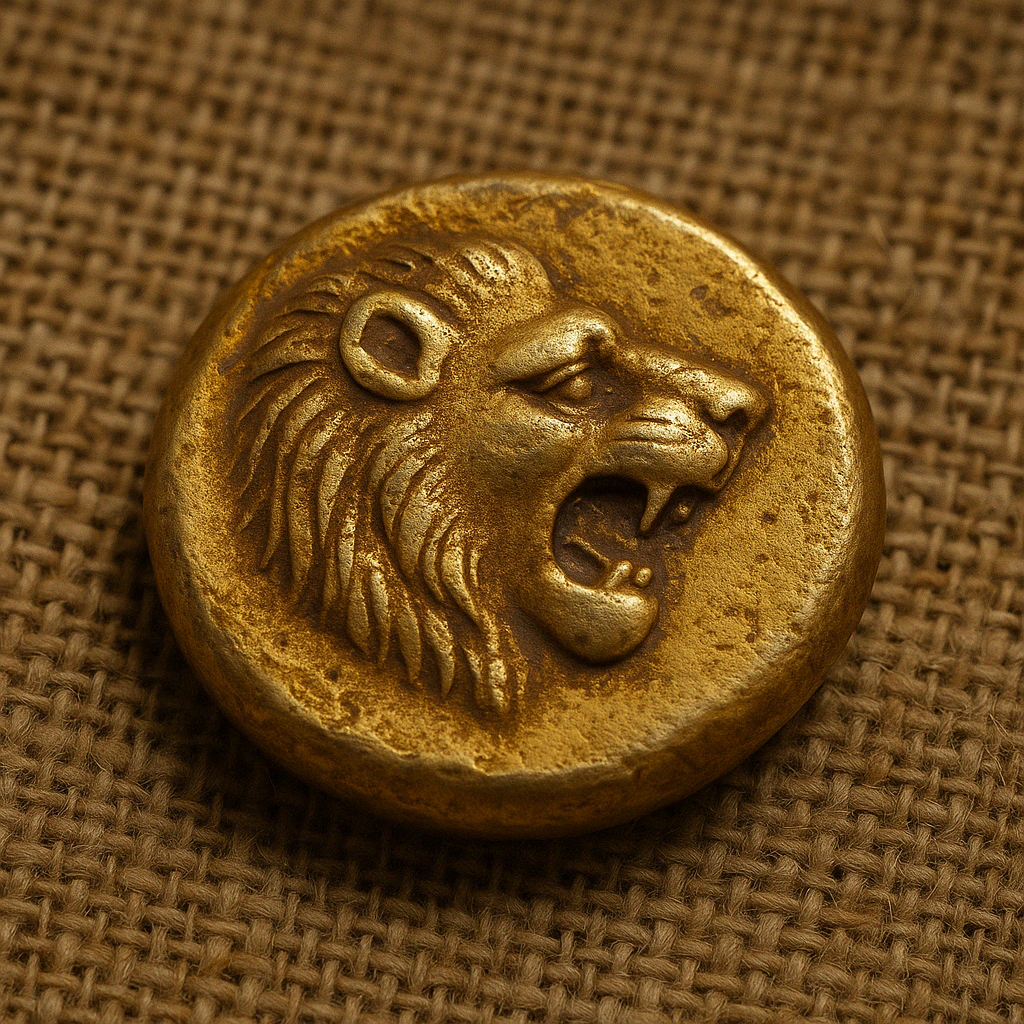The Lydian Gold Coin: Humanity’s First Currency and the Legacy of the Ancient Kingdom

Did you know that the very first coin ever minted came from a small kingdom in what is now western Turkey? Known as the Lydian gold coin, this ancient piece of electrum—a natural alloy of gold and silver—was struck in the 7th century BCE by the Kingdom of Lydia. Featuring the fierce image of a lion’s head, this revolutionary coin sparked the birth of a monetary economy and transformed the way people traded.
Under King Croesus, Lydia introduced standardized gold coinage that was both pure and precisely weighed, setting a precedent that would ripple across civilizations. The phrase “as rich as Croesus” didn’t come from nowhere—Lydia was that prosperous.
The Design of the Lydian Coin
Front Design: The Symbol of Power
Lydian coins were stamped with a left-facing lion’s head, the royal emblem of Lydia. Interestingly, the extent of the lion’s body visible on the coin was used to indicate its weight and value. This wasn’t just an artistic choice—it was a smart, visual cue for merchants.
To create this striking image, ancient craftsmen likely hammered a blank coin from the reverse side using a silver anvil, which pushed the surface upward before carving the lion’s head in relief. A brilliant anti-counterfeiting technique for the time.
Inscriptions? Not Quite.
Unlike many later coins, early Lydian currency did not include inscriptions. There’s some mention of the term “Walwet” possibly appearing on a few, but the coins relied primarily on visual symbols for identification. No rulers’ names, no dates—just a lion speaking for the state.
What About the Reverse?
Early Lydian coins generally had a simple punch mark on the back—a leftover from the minting process rather than a designed reverse. This crude impression was the mark of ancient minting methods, not decoration.
The Makers Behind the Money: A Brief History of Lydian Kings
The development of coinage in Lydia unfolded across multiple reigns:
King Gyges (c. 670 BCE): Credited with producing the first metal coinage, using electrum containing 73% gold and 27% silver.
King Sadyattes (r. 630–620 BCE): Possibly oversaw the first official minting of Lydian coins.
King Alyattes (r. 619–560 BCE): Standardized the quality of electrum coins, enhancing trust in Lydian money.
King Croesus (r. 560–546 BCE): Took things further by issuing the first pure gold coins with uniform weight—a revolutionary leap.
Croesus also introduced a method to separate gold from electrum using a crucible with salt at high temperatures—an early form of refining. The result? Gold coins so pure and reliable they were used across borders.
The Rise and Fall of the Lydian Kingdom
Located at the crossroads of East and West, Lydia’s capital, Sardis, thrived as a trade hub between Mesopotamia and the Aegean. Its wealth was driven in part by the Pactolus River, a natural source of electrum.
Lydia reached its peak under Croesus but eventually fell to the Persian Empire in 546 BCE after a fateful war with Cyrus the Great. Despite its demise, Lydia’s legacy lived on through its groundbreaking monetary system.
A Technological Leap: Electrum and Coin Production
What Is Electrum?
Electrum is a naturally occurring alloy of gold and silver, known for its pale yellow, amber-like hue. It’s what gave Lydian coins their signature look. Early on, coins were made directly from river-sourced electrum, before Lydians learned to refine gold and silver separately.
How Were the Coins Made?
Croesus’s era saw some impressive metallurgy. Here’s a simplified version of their technique:
Gold nuggets were hammered into thin sheets.
They were placed in a crucible with salt.
Heated to around 800°C, impurities were burned off, yielding purified gold.
Once minted, each coin was hand-stamped with a lion to certify its value—a true artisanal process.
Why It Matters: The Legacy of the Lydian Coin
The Birth of the Monetary Economy
Historians like Herodotus credited the Lydians as the first people to use coinage and to run retail markets. These coins were state-issued and bore marks of value—making them the first official currency. This innovation laid the foundation for value-based trade, allowing markets to flourish.
Spreading Across the Ancient World
Lydia’s monetary system didn’t die with the kingdom. Persia adopted it (think Darius’s gold Daric), and soon Greece introduced the silver drachma. Even India’s coinage was inspired by this early model. Croesus’s coins became trusted beyond Lydia’s borders, arguably launching the world’s first gold standard.
Final Thoughts
The Lydian gold coin was more than just a piece of metal—it was a technological, economic, and cultural milestone. It signaled the birth of money as we know it, set the stage for modern economies, and proved that even a small kingdom could change the world.
From the lion-stamped electrum of Gyges to the refined gold of Croesus, Lydia’s legacy shines through every coin struck since. In a very real sense, every modern currency is a descendant of that first bold idea from ancient Anatolia.
